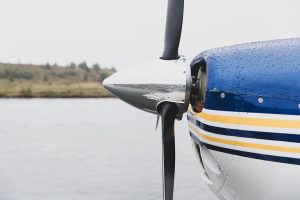There are many incredible bodies of water where you can fish in Quebec. Make sure that you plan your fishing trip several months in advance by booking an outfitter, a hunting and fishing camp, or a private cottage bordering a lake or river. Most importantly, you should do some research about the fishing area, the fish species found there, and the fishing regulations in Quebec.
How long does a fishing trip last?
How long a fishing trip lasts depends on where you go, what species you’re fishing, and your budget. Not only is every site unique, but your fishing style will also influence how long you spend on the water. Offshore fishing is not the same as nearshore fishing. You should aim for at least 5 days to explore a fishing spot.
What should I bring on a Quebec fishing vacation?
It is good to gather as much information about the location of your outfitter or destination before your fishing vacation in order to know exactly what to bring. Where you go will tell you the clothing, type of baits, and outdoor materials you should bring.
Outfitters Only Accessible by Seaplane
Clothing Essentials
It’s important to bring high-quality apparel and layering alternatives, especially for fishing adventures in colder areas such as Alaska or Canada. Make sure you have lots of waterproof clothing, as well as additional underwear and socks in case you get wet.
Here is a list of cold-weather essentials that you should never travel without:
- Quality rain gear: Purchase the highest-quality rain gear you can afford, which includes more than just a jacket. In a strong downpour, waterproof pants, footwear, caps, and gloves will all keep you dry. During a stroll to your fishing area or a long boat trip, it’s easy to get damp.
- Wool or synthetic socks and undergarments: Make sure you bring plenty of additional socks and underwear. Even if you have entirely waterproof gear, if you are out in the rain for an extended amount of time, you will become saturated. Even if you get wet, wool and synthetic materials will keep you warm, and they dry rapidly once the day is done.
- Layering pieces: It’s important to layer up as much as possible while going on particularly cold fishing expeditions, such as winter steelhead or ice fishing. Polar fleece is a fantastic alternative that is available in a variety of thicknesses and weights. You should bring a pair of sweatpants and a couple of fleece pullovers, at the very least.
- Heavy jacket: A substantial down or synthetic jacket is required in the coldest temperatures. If you have room in your backpack, it’s always a good idea to bring something warm in case of a cold spell. It can be a lifesaver on a lengthy morning boat ride or after a fall in the water, even in mild weather.
- Insulated hat and gloves: Many people dislike fishing while wearing gloves, but there are a variety of fingerless choices that will keep you going when the going gets tough. Keep your head toasty with a beanie!
- Appropriate footwear: When wading in fishing lakes, rivers, or the ocean, good wading shoes will protect your feet and keep you from slipping on rocks. Close-toed shoes created expressly for wading are a good option, but sandals can suffice if you’re fishing from a boat.
When is the best time to fish in Northern Canada?
Fishing Equipment
Make sure you pack appropriately for the type of fishing you’ll be doing. The rods, reels, and lines you use should be appropriate for the sort of fish you intend to capture. Pack a backup fishing rod in addition to your primary fishing rod. You won’t have to cut your trip short if something happens to your primary rod. Take an extra reel with you as well.
You should bring an extra spool of line with you. You never know what kind of snags you’ll run into that will cause your line to break. A variety of hooks, sinkers, swivels, and corks are also required. If you’re using artificial lures, bring your favorites.
Two tackle boxes are recommended. One of them carries all the necessities in a small, compact package. This is the one you’ll take down to the water with you, and it can be pocket-sized or worn on your belt. Extra equipment and supplies, as well as any tools you desire, should be stored in your other tackle box. This is the backup box that can be left in the vehicle.
Other fishing equipment to pack:
- Fishing net to scoop up the fish at the end of the fight
- Long-nose pliers to remove hooks
- Knives to clean the fish on the spot to keep the filets cool
- Tape measure to document your catch
Other supplies
- Medication: If you need to take any medications, make sure you get them filled ahead of time and bring them with you in your carry-on if you’re traveling.
- Sunscreen: Always pack sunscreen, whether you’re in a chilly or hot climate. Even if there is cloud cover, being outside for long periods of time exposes your skin to dangerous UV rays.
- Insect repellent: If you let them, bugs will ruin your holiday. Make sure to buy insect repellent.
- First aid kit: On the water, always have a small first-aid kit with you. It should contain the essentials and come in handy for cuts and scrapes, insect bites, headaches, and other minor injuries that can occur outside. Bandages, alcohol swabs, gauze, medical tape, pain medicines, antihistamines, and antibiotic ointment should all be included in your first aid kit.
- Passport, visas, and other required documentation: The worst feeling in the world is arriving at the airport or border and discovering that your documentation is on your nightstand at home. Don’t let this happen and double-checked all the documents you need to bring!
Organize a fishing trip
It’s not easy to pack for a fishing trip, but it’s part of the fun and it builds suspense. A packing checklist is an excellent approach to guarantee that you do not forget anything important. After all, you don’t want to travel to your destination only to discover you forgot your rain gear at home while it’s pouring outside. Air Tunilik works hand in hand with Quebec outfitters to promote local tourism, transport your fishing equipment, and orchestrate arrivals and departures by seaplane throughout the season.






